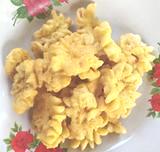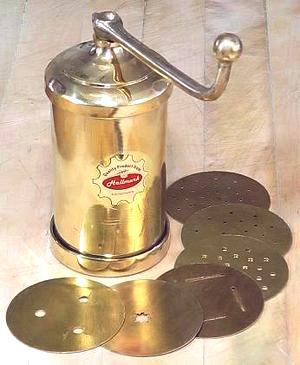The names and forms of these items are extremely flexible, so don't be at all surprised by one form being called by the name given here for another form. The mix of flours used does more to define the product than the shape. Many forms are also produced by hand, rather than with the press, with the names sometimes prefixed by "Kai" (hand).
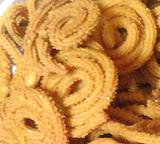
Chakli
[Chakkuli (Kannada); Dantkali (Odisha); Murukku (Tamil); Chakali (Marathi); Chakri (Gujarati); Chakralu, Jantikalu (Telugu); Chakri, Chakkuli (Konkani)]These deep fried items are quite popular in India,
both as a snack, often from street vendors, or as a breakfast item. They are
made from a mix of flours, Rice, Bengal Gram (desi chickpeas), and Black Gram
(urad beans). These are mixed with various spices. They are made with a disk
having a single star shaped hole, then coiled, and deep fried.
Photo distributed under license Creative Commons
Attribution-ShareAlike v3.0 Unported.
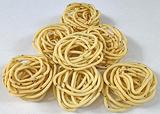
Murukku
These deep fried items are quite popular in Tamil Nadu, often made in large quantity to serve during festivals. Made from a mix of Rice flour and Black Gram flour (urad beans), with various spices added, they are relatively hard. They can be made with a disk having three round holes and are usually randomly curled and deep fried. Mullu Muruku is a version with a rough texture for added crunchiness. Photo by Keerthiga distributed under license Creative Commons Attribution-ShareAlike v4.0 International.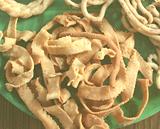
Pakoda Murukku
Another form popular in Tamil Nadu, made from the same mix of Rice flour and Black Gram flour (urad beans) as the regular Murukku. They can be made with the disk having four slots in it, then deep fried. Photo by Manavatha contributed to the Public Domain.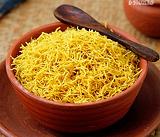
Sev / Omapodi
This version is made from Besan (desi chickpea flour) with various spices added. It is often used as a topping for various dishes, and also mixed with other ingredients, such as Poha (beaten rice). It can be made with the multi-holed disk with the largest holes in the photo above, then deep fried. Photo by The Grand Sweets And Snacks distributed under license Creative Commons Attribution-ShareAlike v4.0 International.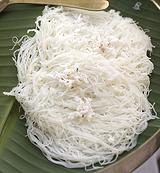
Idiyappam
[String Hoppers; Idiyappam, Noolappam, Noolputtu, Sevai (Tamil Nadu); Semige, Semé da addae (Tulu); Chomai (Kannada); Putu mayam (Malaysia); Putu mayang (Indonesia);]These are very popular in Tamil Nadu and Sri Lanka, but also in Karala,
Karnataka, Malaysia and Indonesia. Traditionally, they are made as small flat
rovings of rice flour (the photo shows three piled up) using a press with
a disk with very small holes. Traditionally, they are formed into tiny baskets
and steamed, but they may also be formed in the depressions of
Idli Steamer trays for steaming. They
are usually served with spicy sambars or curries and a chutney, for breakfast
or dinner, but seldom at lunch.
Photo by Charles Haynes distributed under license
Creative Commons
Attribution-ShareAlike v3.0 Generic.
